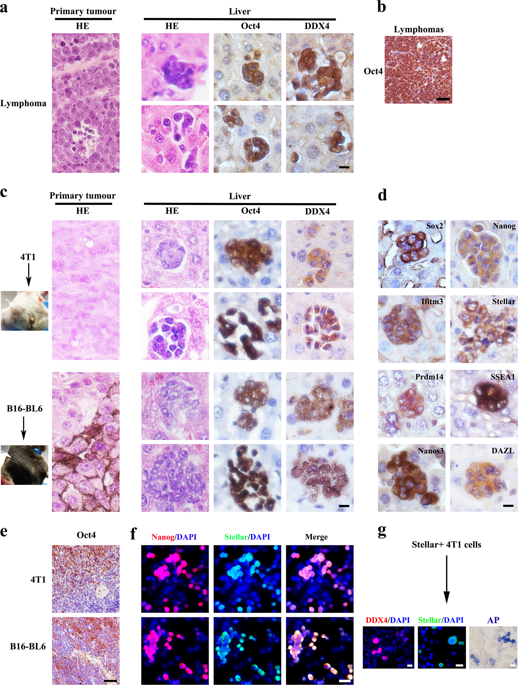Cell Discovery ( IF 33.5 ) Pub Date : 2020-03-24 , DOI: 10.1038/s41421-020-0145-3 Chunfang Liu 1, 2 , Zhan Ma 1 , Zhen Cai 2 , Fengyu Zhang 1 , Cheng Liu 1 , Tingjin Chen 2 , Danni Peng 2 , Xiaohong Xu 3 , Hui-Kuan Lin 2

|
Liver metastasis, characterized by the spread of tumors to the liver from other areas, represents a deadly disease with poor prognosis. Currently, there is no effective therapeutic strategies and/or agents to combat liver metastasis primarily due to the insufficient understanding of liver metastasis. To develop a promising strategy for targeting liver metastasis, understanding of a cell origin responsible for liver metastasis and how this cell can be pharmacologically eliminated are therefore crucial. Using diverse tumor models including p53−/− genetic mouse model and syngeneic tumor models, we identified primordial germ cell (PGC)-like tumor cells, which are enriched in earliest liver micro-metastasis (up to 99%), as a cell origin of liver metastasis. PGC-like tumor cells formed earliest micro-metastasis in liver and gradually differentiated into non-PGC-like tumor cells to constitute late macro-metastasis in the course of tumor metastasis. The liver metastasis-initiating cells (PGC-like tumor cells) display cell renewal and differentiation capabilities, resemble primordial germ cells (PGCs) in morphology and PGC marker gene expression, and express higher level of the genes linked to metastasis and immune escape compared with non-PGC-like tumor cells. Of note, Stellarhigh PGC-like tumor cells, but not Stellarlow non-PGC-like cells, sorted from primary tumors of p53−/− mice readily form liver metastasis. Depletion of PGC-like tumor cells through genetic depletion of any of key germ cell genes impairs liver metastasis, while increased PGC-like tumor cells by SMAD2 knockout is correlated with markedly enhanced liver metastasis. Finally, we present the proof of principle evidence that pharmacologically targeting BMP pathways serves as a promising strategy to eliminate PGC-like tumor cells leading to abrogating liver metastasis. Collectively, our study identifies PGC-like tumor cells as a cell origin of liver metastasis, whose depletion by genetically targeting core PGC developmental genes or pharmacologically inhibiting BMP pathways serves a promising strategy for targeting liver metastasis.
中文翻译:

小鼠肿瘤模型中原始生殖细胞样细胞作为肝转移起始细胞的鉴定
肝转移的特点是肿瘤从其他部位扩散到肝脏,是一种预后不良的致命疾病。目前,主要由于对肝转移认识不足,尚无有效的治疗策略和/或药物来对抗肝转移。因此,为了开发一种有前途的针对肝转移的策略,了解导致肝转移的细胞起源以及如何通过药理学消除这种细胞至关重要。使用包括p53 −/−遗传小鼠模型和同基因肿瘤模型在内的多种肿瘤模型,我们鉴定了原始生殖细胞(PGC)样肿瘤细胞,这些细胞在最早的肝脏微转移中富集(高达99%)作为细胞起源肝转移。PGC样肿瘤细胞在肿瘤转移过程中最早形成肝脏微转移,并逐渐分化为非PGC样肿瘤细胞,构成晚期宏观转移。肝转移起始细胞(PGC样肿瘤细胞)表现出细胞更新和分化能力,在形态和PGC标记基因表达上类似于原始生殖细胞(PGC),并且与转移和免疫逃逸相关的基因表达水平高于肝转移起始细胞(PGC样肿瘤细胞)。非 PGC 样肿瘤细胞。值得注意的是,从p53 -/−小鼠的原发性肿瘤中分选的 Stellar高PGC 样肿瘤细胞,而不是 Stellar低非 PGC 样细胞,很容易形成肝转移。通过任何关键生殖细胞基因的遗传缺失来消除 PGC 样肿瘤细胞会损害肝转移,而通过 SMAD2 敲除增加 PGC 样肿瘤细胞与肝转移显着增强相关。最后,我们提出了原则性证据,证明药物靶向 BMP 途径是消除 PGC 样肿瘤细胞从而消除肝转移的有前途的策略。总的来说,我们的研究将 PGC 样肿瘤细胞确定为肝转移的细胞起源,通过基因靶向核心 PGC 发育基因或药理学抑制 BMP 途径来消除 PGC 样肿瘤细胞,为靶向肝转移提供了一种有前景的策略。


























 京公网安备 11010802027423号
京公网安备 11010802027423号